Answer ·
Military Aviation
Are there any significant perks of flying large aircraft in the US military such as the C-17, KC-135, B-52, C-130 over fighters?
Stacy Tidwell
Stacy Tidwell
Updated 10m ago · Upvoted by Doug Hanchard, Aviator with 7,000+ hours CPL, ATPL Pitts S1 to DC-8's and B-707's. and Rob Stewart, former SMSgt (E-8) at U.S. Air Force (1978-1999)
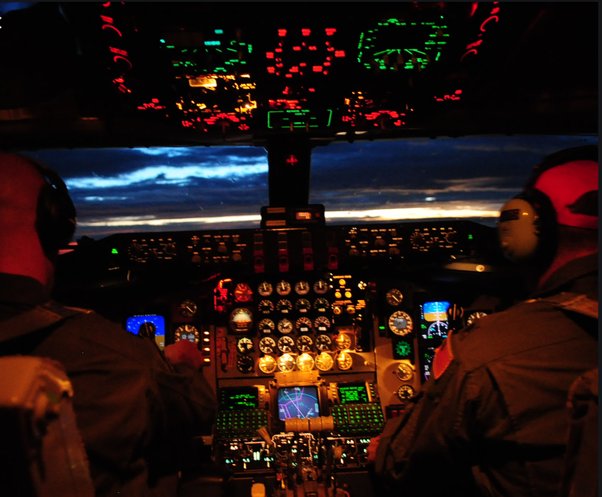 I was the only pilot in my UPT class to request a KC-135 as my first choice.
My second choice was the EC-135 Looking Glass. My third choice: KC-135Q for the SR-71. All these aircraft belonged to the Strategic Air Command (SAC).
My Flight Commander (F-4/F-16) was a terrific pilot from the Tactical Air Command (TAC). He was also a great leader. Given my class standing, he chastised me for “lack of ambition” and “not maximizing my potential.”
I said: Sir, I admire you. You’ve always been a straight shooter. But I still want a KC-135.
He looked down, shook his head, and muttered something. It sounded like “retarded.”
Three weeks earlier, my instructor pilot (IP) and I had an identical conversation. I am from the Deep South and he was from Maine. We really liked each other — probably because I could not understand half of what he said.
Every Sunday, he ate steamahs. No one in my flight could translate. If you look up Yankee in the dictionary, you will probably find his picture.
I was the only pilot in my UPT class to request a KC-135 as my first choice.
My second choice was the EC-135 Looking Glass. My third choice: KC-135Q for the SR-71. All these aircraft belonged to the Strategic Air Command (SAC).
My Flight Commander (F-4/F-16) was a terrific pilot from the Tactical Air Command (TAC). He was also a great leader. Given my class standing, he chastised me for “lack of ambition” and “not maximizing my potential.”
I said: Sir, I admire you. You’ve always been a straight shooter. But I still want a KC-135.
He looked down, shook his head, and muttered something. It sounded like “retarded.”
Three weeks earlier, my instructor pilot (IP) and I had an identical conversation. I am from the Deep South and he was from Maine. We really liked each other — probably because I could not understand half of what he said.
Every Sunday, he ate steamahs. No one in my flight could translate. If you look up Yankee in the dictionary, you will probably find his picture.
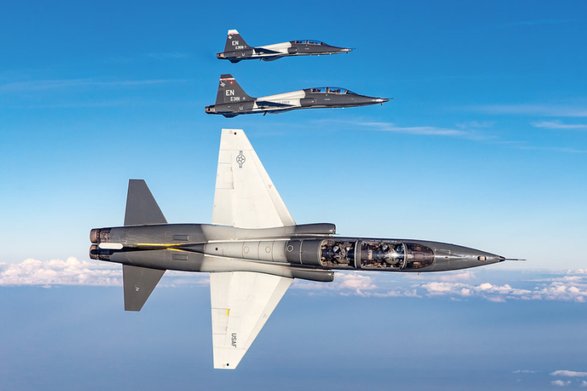 My IP hooked (failed) me on a 4-ship formation ride. He said my tactical maneuvers were not aggressive enough. I said: Sir, I do not think that’s fair.
He immediately jumped to his feet. He bellowed at me in front of 36 instructors and students:
Fay-uh! Fay-uh!!
This is the United States Air Force.
There is no fay-uh!
Military pilots are not afraid of dying. They are afraid of screwing up.
On our very first KC-135 mission without instructors, a fuel coupling broke. The boom operator found fuel pooling inside the boom pod. This is an uncommon emergency, but I was not concerned. We headed back toward base.
While I judged this a “straightforward” emergency, the Navigator and Boom Operator got the jitters. I assured them everything would be fine. Pilots are trained to handle multiple and compound emergencies.
I asked my Boom Operator for another status report. He sprinted back to the cockpit with saucer eyes: Pilot! Pilot! It’s bubbling like a fucking Jacuzzi back there!
That still makes me laugh today. Civilian life is boring compared to the military.
My IP hooked (failed) me on a 4-ship formation ride. He said my tactical maneuvers were not aggressive enough. I said: Sir, I do not think that’s fair.
He immediately jumped to his feet. He bellowed at me in front of 36 instructors and students:
Fay-uh! Fay-uh!!
This is the United States Air Force.
There is no fay-uh!
Military pilots are not afraid of dying. They are afraid of screwing up.
On our very first KC-135 mission without instructors, a fuel coupling broke. The boom operator found fuel pooling inside the boom pod. This is an uncommon emergency, but I was not concerned. We headed back toward base.
While I judged this a “straightforward” emergency, the Navigator and Boom Operator got the jitters. I assured them everything would be fine. Pilots are trained to handle multiple and compound emergencies.
I asked my Boom Operator for another status report. He sprinted back to the cockpit with saucer eyes: Pilot! Pilot! It’s bubbling like a fucking Jacuzzi back there!
That still makes me laugh today. Civilian life is boring compared to the military.
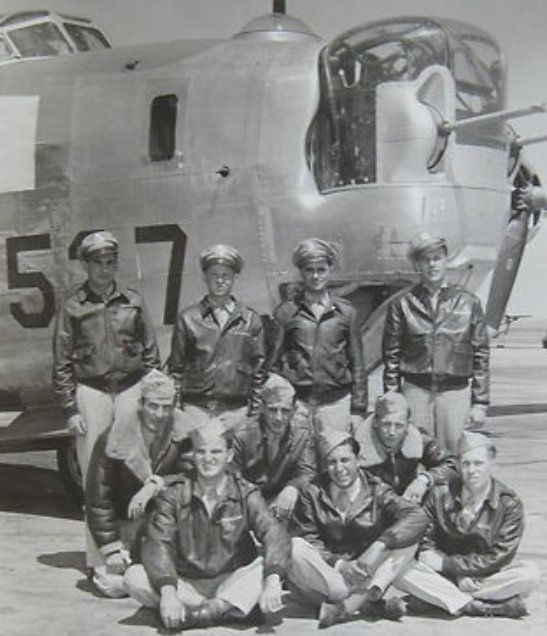 My father flew in the 456th Bomb Group during World War II. He was highly decorated and retired after 27 years — mostly in SAC.
I was born overseas on a U.S. military base. Growing up stateside, all my friends had long hair and wild clothes. My brothers and I had crew cuts and shined boots.
Throughout my career, Dad gave me pointers. These proved invaluable. He told me:
Work the system or the system works you.
After training, my crew and I volunteered for every overseas task force.
Hawaii
Europe
Alaska
Wake, Guam, and Pacific Islands
Unlike C-5, C-17, and C-130 crews, tankers tend to stay in one place for 6–8 weeks. That meant lots of flying from 0400 to 1400. Then, sandy beaches and sightseeing in the afternoon.
SAC initiated the ACE Program — Accelerated Copilot Enrichment.
As copilots, we would fly tankers during the week and small jets (T-37 or T-38) on the weekends. CINCSAC designed the program to increase combat crew training.
SAC saved huge amounts of money by upgrading our skills on small jets rather than the multi-engined KC-135, EC-135, KC-10, B-52, and B-1.
We respected The Brass and their focus on national security. But as young copilots, we had a different focus: warm locales and single women. Our favorite destinations were NAS Key West and Nellis AFB (Las Vegas).
On occasion, it was -20 degrees at home base. When there was blowing snow, we became very motivated to do extra flight training on the weekend.
In the T-38, you could skyhook it. That’s where you would zoom up, cruise well above other aircraft, and then zoom down. It might be -20 degrees in Minot, Grand Forks, and Loring. But it was always 82 degrees in Margaritaville…
After one exceptional weekend, it was my buddy’s turn to do the pre-flight. He failed to notice a broken latch on the cargo compartment.
On climbout, he pulled some g’s. Those g forces opened a crevice in the rubber seal for about 2 seconds. His empty gym bag was sucked out. It floated to Earth like a leaf.
We were over a K-Mart. The bag fell directly at the feet of a man waiting for his wife. As it turned out, he was a retired Air Force Colonel.
What are the chances?
By the time we landed, the Deputy Commander for Operations had already summoned us. By name.
My buddy’s date of rank made him 3 days senior to me. He was also pilot-in-command and at the controls. He said simply: I have no excuse, Sir. I take full personal responsibility.
Junior officers are trained to never make excuses. Still, I appreciated his nobility. I was dismissed.
Military justice is not swift—it is instantaneous. The DO is judge, jury, and executioner. There is no appeal.
Day after day, my buddy memorized regulations. He wore dress blues and studied diligently from 0700 to 1730. I would visit him each day in the Wing Headquarters building.
The DO was a bona fide war hero who spent six years as a prisoner-of-war. He finally took pity on my friend, and returned him to flying status. At that point, my buddy could have written the regulations.
Back at the squadron, the ribbing was merciless: SAC bombs the enemy. Not K-Mart!
Flying the tanker was like flying a Cadillac. These missions were especially fun:
Supporting Navy and Marine fighters (TDY Hawaii)
Supporting spy missions over the North Pole (TDY Alaska)
Supporting NASA Space Shuttle launches (TDY Spain)
Supporting NATO AWACs (TDY England and Germany)
Supporting Red Flag (TDY Las Vegas)
Supporting Provide Comfort (TDY Turkey)
Supporting Air Force One & Special Air Missions (TDY Azores)
The space program produced many plum assignments. NASA would routinely delay space launches by 4–10 days. My crew must have visited every pub, castle, museum, and pub in Europe.
There were three keys to my Master Plan:
1 of 3
Stay “far from the flag pole.” In other words, outside the CONUS. My crew would volunteer for any mission to avoid Alert at our home base.
We once deployed to Eielson AFB, Alaska in January — and were delighted to be there. The briefer made us chuckle: Don’t worry about extra MREs. If you crash land past the North Pole, you will be Popsicles by the time we reach you.
My father flew in the 456th Bomb Group during World War II. He was highly decorated and retired after 27 years — mostly in SAC.
I was born overseas on a U.S. military base. Growing up stateside, all my friends had long hair and wild clothes. My brothers and I had crew cuts and shined boots.
Throughout my career, Dad gave me pointers. These proved invaluable. He told me:
Work the system or the system works you.
After training, my crew and I volunteered for every overseas task force.
Hawaii
Europe
Alaska
Wake, Guam, and Pacific Islands
Unlike C-5, C-17, and C-130 crews, tankers tend to stay in one place for 6–8 weeks. That meant lots of flying from 0400 to 1400. Then, sandy beaches and sightseeing in the afternoon.
SAC initiated the ACE Program — Accelerated Copilot Enrichment.
As copilots, we would fly tankers during the week and small jets (T-37 or T-38) on the weekends. CINCSAC designed the program to increase combat crew training.
SAC saved huge amounts of money by upgrading our skills on small jets rather than the multi-engined KC-135, EC-135, KC-10, B-52, and B-1.
We respected The Brass and their focus on national security. But as young copilots, we had a different focus: warm locales and single women. Our favorite destinations were NAS Key West and Nellis AFB (Las Vegas).
On occasion, it was -20 degrees at home base. When there was blowing snow, we became very motivated to do extra flight training on the weekend.
In the T-38, you could skyhook it. That’s where you would zoom up, cruise well above other aircraft, and then zoom down. It might be -20 degrees in Minot, Grand Forks, and Loring. But it was always 82 degrees in Margaritaville…
After one exceptional weekend, it was my buddy’s turn to do the pre-flight. He failed to notice a broken latch on the cargo compartment.
On climbout, he pulled some g’s. Those g forces opened a crevice in the rubber seal for about 2 seconds. His empty gym bag was sucked out. It floated to Earth like a leaf.
We were over a K-Mart. The bag fell directly at the feet of a man waiting for his wife. As it turned out, he was a retired Air Force Colonel.
What are the chances?
By the time we landed, the Deputy Commander for Operations had already summoned us. By name.
My buddy’s date of rank made him 3 days senior to me. He was also pilot-in-command and at the controls. He said simply: I have no excuse, Sir. I take full personal responsibility.
Junior officers are trained to never make excuses. Still, I appreciated his nobility. I was dismissed.
Military justice is not swift—it is instantaneous. The DO is judge, jury, and executioner. There is no appeal.
Day after day, my buddy memorized regulations. He wore dress blues and studied diligently from 0700 to 1730. I would visit him each day in the Wing Headquarters building.
The DO was a bona fide war hero who spent six years as a prisoner-of-war. He finally took pity on my friend, and returned him to flying status. At that point, my buddy could have written the regulations.
Back at the squadron, the ribbing was merciless: SAC bombs the enemy. Not K-Mart!
Flying the tanker was like flying a Cadillac. These missions were especially fun:
Supporting Navy and Marine fighters (TDY Hawaii)
Supporting spy missions over the North Pole (TDY Alaska)
Supporting NASA Space Shuttle launches (TDY Spain)
Supporting NATO AWACs (TDY England and Germany)
Supporting Red Flag (TDY Las Vegas)
Supporting Provide Comfort (TDY Turkey)
Supporting Air Force One & Special Air Missions (TDY Azores)
The space program produced many plum assignments. NASA would routinely delay space launches by 4–10 days. My crew must have visited every pub, castle, museum, and pub in Europe.
There were three keys to my Master Plan:
1 of 3
Stay “far from the flag pole.” In other words, outside the CONUS. My crew would volunteer for any mission to avoid Alert at our home base.
We once deployed to Eielson AFB, Alaska in January — and were delighted to be there. The briefer made us chuckle: Don’t worry about extra MREs. If you crash land past the North Pole, you will be Popsicles by the time we reach you.
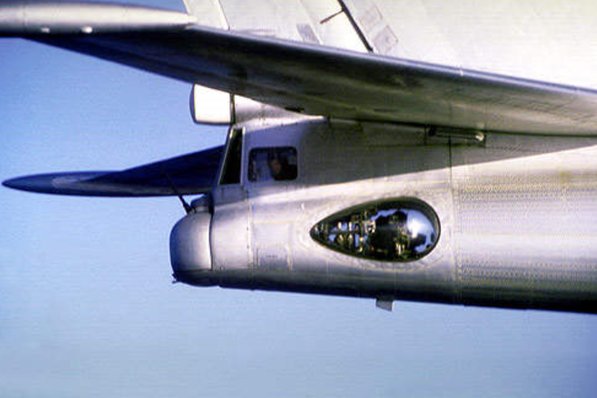 TU-95s often tested U.S. defenses. The Bear has plexiglass bubbles from which observers film U.S. aircraft.
Russian photographers seemed to have poor depth perception. To gauge focal length, they would extend their middle finger.
2 of 3
Volunteer for every hairy mission launching at 0100.
TU-95s often tested U.S. defenses. The Bear has plexiglass bubbles from which observers film U.S. aircraft.
Russian photographers seemed to have poor depth perception. To gauge focal length, they would extend their middle finger.
2 of 3
Volunteer for every hairy mission launching at 0100.
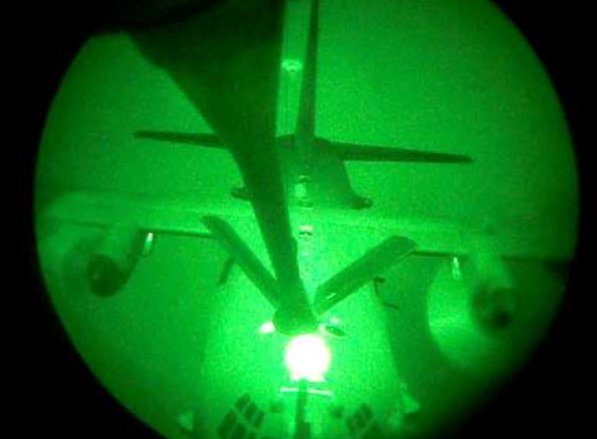 Top Secret sorties meant you were detailed to other headquarters. Upon going dark, Mother SAC in Omaha relinquished day-to-day control. At least for awhile.
Plus, difficult missions keep you sharp. As my young copilot said: extra frosty.
Special Operations capabilities have been greatly expanded in recent years.
Dark World Of Air Refuelers in Special Ops
3 of 3
Bribe all the Colonels’ secretaries with gifts upon our return to the CONUS. They especially liked Belgian chocolate, French perfume, and Spanish black soap.
At home base, we were occasionally placed on Cockpit Alert.
When enemy submarines moved close to U.S. shores, tanker and bomber crews might spend hours in their cockpits. Our intelligence people were constantly calculating safe separation time (number of minutes for enemy missiles to reach our base).
I devised an initiation for new Lieutenants. I would hand them a large rectangle of tin foil. They were then instructed to stand 73.5 paces in front of the aircraft so we could “tune the radar.”
After standing in deep snow drifts, these fresh-faced newbies would suddenly get a look of recognition. That’s the moment they realized there was no power on any alert aircraft until after engine start.
As they trudged back to the cockpit through the swirling snow, there was much good-natured ribbing. They were now officially in the family.
There was one new guy who never caught on. I finally told him the radar was now “fully tuned.” We invited him back to the cockpit for coffee, poker, and bad jokes.
Alert was monotonous. Spain, Turkey, and Hawaii were different. When we deployed, other crews assumed “Sub Duty.”
After long periods of Alert, the bad guys were Communist Squids. We loudly questioned their intelligence, parentage, and love of furry animals.
I quickly accumulated 40% more flight hours than my peers. That led to my early upgrade. My crew would volunteer for any mission.
We carried a wide variety of passengers:
Army troops
Local Mayor and city council to March AFB, California
Generals to Offutt AFB, Nebraska
Scouts and military cadets on training sorties
Special forces
News media on orientation flights
Junior Officers to AFMPC at Randolph AFB, Texas
Helicopter pilots to Langley AFB, Virginia
Spooks
Retirees to Hickam AFB, Hawaii
Navy sailors to Wake Island and Guam
Marines to Iwakuni, Japan
Some were HHQ taskings and others were Space Available. Space A means anyone with credentials can hitch a ride.
We had the most fun with a group of Miss Universe contestants. Public Affairs arranged for them to fly on a regular training sortie, with television media present at takeoff.
The Squadron Commander told us: This is a high profile mission. I selected you myself. I know your crew will demonstrate total professionalism. This will be 100% by-the-book.
As he left the room. we all snapped to attention. But my crew was already starting to chortle. I told them to pipe down.
13 crew chiefs launched us that Thursday morning. Some of them were wearing Comm and Weather patches — not Maintenance.
These “instant crew chiefs” could not distinguish hydraulic fluid from Holy Water. But they did their best to look busy.
Public Affairs delivered the ladies precisely on time. These lookers dressed like they were going to La Bohème and a 5-star restaurant. Our selfless crew chiefs helped each contestant find her seat aboard the jet.
The KC-135 had a special system for celestial navigation. During Cel Nav, the navigator could adjust the jet’s heading from his console. This console was 5 feet behind the pilots.
Evil nations broadcast fake navigational signals to U.S. military aircraft. Their goal is to lure you into their airspace and kill you. They want the wreckage to fall in their territory so they can claim you were spying. Navigating by the stars (like Magellan) obviates the need for navigation signals.
When airborne, we had a trick we played on Cub Scouts. My crew decided to try it on the Miss Universe contestants.
My boom operator brought them up to the cockpit in small groups. I then told them:
U.S. technology is so advanced, I can now control this jet using nothing but my voice.
The copilot and I would hold our hands up in the air. We both stared at the magnetic compass. Then, I would say in my best Swami voice:
Aircraft, obey my commands. Turn left 20 degrees. Standard rate turn. Execute!
The navigator, sitting at his station behind the ladies, would very slowly roll the aircraft into a banked left turn.
Aircraft! I said 20 degrees.
Pay attention when I talk to you!
Now turn right 20 degrees. And make it snappy!
The navigator quickly rolled the jet right.
Some of the beauties were shocked by this advanced American technology. Their jaws dropped 10% of the time — about the same as Cub Scouts. A few stared at the magnetic compass. Maybe they expected the aircraft to argue with me.
After awhile, my copilot was laughing so hard he had to don his oxygen mask.
Not everyone was impressed. This German knockout gave me the evil eye. Maybe she heard about my father in World War II…
Top Secret sorties meant you were detailed to other headquarters. Upon going dark, Mother SAC in Omaha relinquished day-to-day control. At least for awhile.
Plus, difficult missions keep you sharp. As my young copilot said: extra frosty.
Special Operations capabilities have been greatly expanded in recent years.
Dark World Of Air Refuelers in Special Ops
3 of 3
Bribe all the Colonels’ secretaries with gifts upon our return to the CONUS. They especially liked Belgian chocolate, French perfume, and Spanish black soap.
At home base, we were occasionally placed on Cockpit Alert.
When enemy submarines moved close to U.S. shores, tanker and bomber crews might spend hours in their cockpits. Our intelligence people were constantly calculating safe separation time (number of minutes for enemy missiles to reach our base).
I devised an initiation for new Lieutenants. I would hand them a large rectangle of tin foil. They were then instructed to stand 73.5 paces in front of the aircraft so we could “tune the radar.”
After standing in deep snow drifts, these fresh-faced newbies would suddenly get a look of recognition. That’s the moment they realized there was no power on any alert aircraft until after engine start.
As they trudged back to the cockpit through the swirling snow, there was much good-natured ribbing. They were now officially in the family.
There was one new guy who never caught on. I finally told him the radar was now “fully tuned.” We invited him back to the cockpit for coffee, poker, and bad jokes.
Alert was monotonous. Spain, Turkey, and Hawaii were different. When we deployed, other crews assumed “Sub Duty.”
After long periods of Alert, the bad guys were Communist Squids. We loudly questioned their intelligence, parentage, and love of furry animals.
I quickly accumulated 40% more flight hours than my peers. That led to my early upgrade. My crew would volunteer for any mission.
We carried a wide variety of passengers:
Army troops
Local Mayor and city council to March AFB, California
Generals to Offutt AFB, Nebraska
Scouts and military cadets on training sorties
Special forces
News media on orientation flights
Junior Officers to AFMPC at Randolph AFB, Texas
Helicopter pilots to Langley AFB, Virginia
Spooks
Retirees to Hickam AFB, Hawaii
Navy sailors to Wake Island and Guam
Marines to Iwakuni, Japan
Some were HHQ taskings and others were Space Available. Space A means anyone with credentials can hitch a ride.
We had the most fun with a group of Miss Universe contestants. Public Affairs arranged for them to fly on a regular training sortie, with television media present at takeoff.
The Squadron Commander told us: This is a high profile mission. I selected you myself. I know your crew will demonstrate total professionalism. This will be 100% by-the-book.
As he left the room. we all snapped to attention. But my crew was already starting to chortle. I told them to pipe down.
13 crew chiefs launched us that Thursday morning. Some of them were wearing Comm and Weather patches — not Maintenance.
These “instant crew chiefs” could not distinguish hydraulic fluid from Holy Water. But they did their best to look busy.
Public Affairs delivered the ladies precisely on time. These lookers dressed like they were going to La Bohème and a 5-star restaurant. Our selfless crew chiefs helped each contestant find her seat aboard the jet.
The KC-135 had a special system for celestial navigation. During Cel Nav, the navigator could adjust the jet’s heading from his console. This console was 5 feet behind the pilots.
Evil nations broadcast fake navigational signals to U.S. military aircraft. Their goal is to lure you into their airspace and kill you. They want the wreckage to fall in their territory so they can claim you were spying. Navigating by the stars (like Magellan) obviates the need for navigation signals.
When airborne, we had a trick we played on Cub Scouts. My crew decided to try it on the Miss Universe contestants.
My boom operator brought them up to the cockpit in small groups. I then told them:
U.S. technology is so advanced, I can now control this jet using nothing but my voice.
The copilot and I would hold our hands up in the air. We both stared at the magnetic compass. Then, I would say in my best Swami voice:
Aircraft, obey my commands. Turn left 20 degrees. Standard rate turn. Execute!
The navigator, sitting at his station behind the ladies, would very slowly roll the aircraft into a banked left turn.
Aircraft! I said 20 degrees.
Pay attention when I talk to you!
Now turn right 20 degrees. And make it snappy!
The navigator quickly rolled the jet right.
Some of the beauties were shocked by this advanced American technology. Their jaws dropped 10% of the time — about the same as Cub Scouts. A few stared at the magnetic compass. Maybe they expected the aircraft to argue with me.
After awhile, my copilot was laughing so hard he had to don his oxygen mask.
Not everyone was impressed. This German knockout gave me the evil eye. Maybe she heard about my father in World War II…
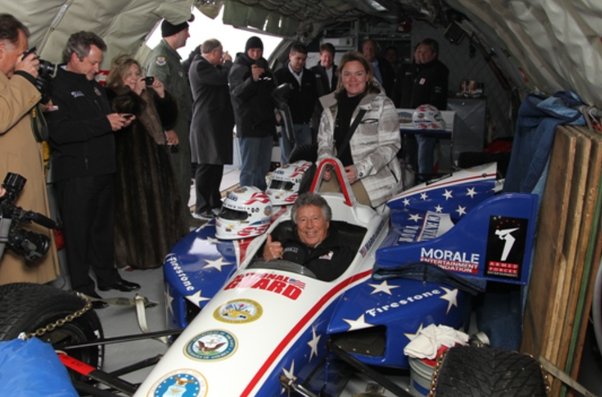 My buddies carried Mario Andretti on a worldwide USO tour. Sometimes, they would drop off the MWR people, go fly a combat crew mission, then return to pick up the civilians. That was an unusual deployment. 50% fun and 50% war zone.
Mr. Andretti is a true American patriot.
The KC-135 is a force multiplier. Tankers are high value targets to our enemies. We had some close calls, especially in these red orbits:
My buddies carried Mario Andretti on a worldwide USO tour. Sometimes, they would drop off the MWR people, go fly a combat crew mission, then return to pick up the civilians. That was an unusual deployment. 50% fun and 50% war zone.
Mr. Andretti is a true American patriot.
The KC-135 is a force multiplier. Tankers are high value targets to our enemies. We had some close calls, especially in these red orbits:
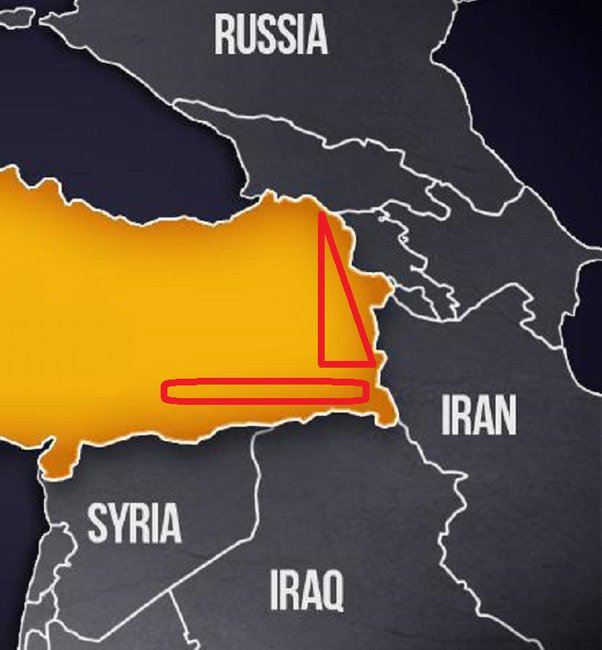 When orbiting, we could be “locked up” by SAM missiles or MiG fighters. This is a bad neighborhood for an unarmed tanker.
On one sortie, the bad guys went way too far. We had F-16s on the wing and A-10s in trail. They were happy to solve our problem.
We volunteered for Desert Shield, Desert Storm, and Provide Comfort. In December 1990, we received sacks of mail, cards, and candy from schoolchildren across the USA.
I was Flight Commander for a 6-ship. My crews missed their families. We were a long way from home — both literally and figuratively. Those Christmas cards boosted morale more than well-wishers ever knew.
When orbiting, we could be “locked up” by SAM missiles or MiG fighters. This is a bad neighborhood for an unarmed tanker.
On one sortie, the bad guys went way too far. We had F-16s on the wing and A-10s in trail. They were happy to solve our problem.
We volunteered for Desert Shield, Desert Storm, and Provide Comfort. In December 1990, we received sacks of mail, cards, and candy from schoolchildren across the USA.
I was Flight Commander for a 6-ship. My crews missed their families. We were a long way from home — both literally and figuratively. Those Christmas cards boosted morale more than well-wishers ever knew.
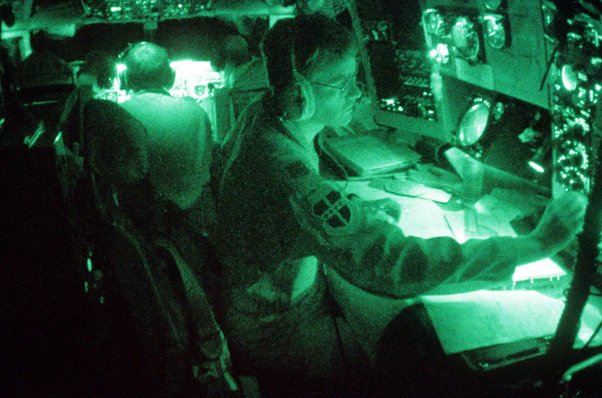 The Gulf War kept us busy. Several times, we had 96 fighters on the wing, refueling, in trail, or closing fast. On those missions, the copilot does all the flying. The Flight Commander directs the aerial ballet while coordinating with AWACs and Joint STARS.
Time on target (TOT) governs every decision. The Air Force executes with extraordinary precision — usually to the second. The civilian world is different.
We often supported spy missions (reconnaissance) against Russia, China, and North Korea. But true Secret Squirrel sorties were rare. One stood out.
While we were deployed overseas to a remote island, the Provisional Wing Commander (O-6) approached me directly. He had extensive knowledge of my personal background. The entire conversation was unusual. The chain of command is normally used to task crew dogs.
He handed me a red TOP SECRET bag containing flight plans, recall codes, and other documents. The red bag got my attention. If any aircrew lost control of a SAC red bag for even a few minutes, codes had to be changed all around the world.
He said: You will fly this mission. Not one word to anyone. This will be a No Comm sortie. Passively monitor HF on channel _______.
You will be given clearance for takeoff with light signals from the tower. Declare MARSA as soon as you are airborne, and then kill your IFF transponder.
No position reporting. No radar. No beacon. No Have Quick. No emissions. No nothing.
Your crew members all have Top Secret (SCI) clearances. But do not fully brief your crew until airborne. After landing, return the red bag to me in the Command Post. I will personally debrief all of you together.
This Colonel definitely had my attention. Long story short…
Over very dark ocean at 0300, we refueled a craft completely unknown to us. This receiver was not in the inventory. Not even whispered. He got his fuel and then showed off his amazing machine. Just for us.
The Air Force has technology beyond Buck Rogers.
My aircrew was constantly applauded for being “fast burners” and “forward in the straps.” We even got our picture in the paper. On the other hand, The Brass never knew about the golf clubs we carried all around the world.
One of the highlights of my career was taking my father on a mission just before he died. You cannot do that in a fighter.
The Gulf War kept us busy. Several times, we had 96 fighters on the wing, refueling, in trail, or closing fast. On those missions, the copilot does all the flying. The Flight Commander directs the aerial ballet while coordinating with AWACs and Joint STARS.
Time on target (TOT) governs every decision. The Air Force executes with extraordinary precision — usually to the second. The civilian world is different.
We often supported spy missions (reconnaissance) against Russia, China, and North Korea. But true Secret Squirrel sorties were rare. One stood out.
While we were deployed overseas to a remote island, the Provisional Wing Commander (O-6) approached me directly. He had extensive knowledge of my personal background. The entire conversation was unusual. The chain of command is normally used to task crew dogs.
He handed me a red TOP SECRET bag containing flight plans, recall codes, and other documents. The red bag got my attention. If any aircrew lost control of a SAC red bag for even a few minutes, codes had to be changed all around the world.
He said: You will fly this mission. Not one word to anyone. This will be a No Comm sortie. Passively monitor HF on channel _______.
You will be given clearance for takeoff with light signals from the tower. Declare MARSA as soon as you are airborne, and then kill your IFF transponder.
No position reporting. No radar. No beacon. No Have Quick. No emissions. No nothing.
Your crew members all have Top Secret (SCI) clearances. But do not fully brief your crew until airborne. After landing, return the red bag to me in the Command Post. I will personally debrief all of you together.
This Colonel definitely had my attention. Long story short…
Over very dark ocean at 0300, we refueled a craft completely unknown to us. This receiver was not in the inventory. Not even whispered. He got his fuel and then showed off his amazing machine. Just for us.
The Air Force has technology beyond Buck Rogers.
My aircrew was constantly applauded for being “fast burners” and “forward in the straps.” We even got our picture in the paper. On the other hand, The Brass never knew about the golf clubs we carried all around the world.
One of the highlights of my career was taking my father on a mission just before he died. You cannot do that in a fighter.
This was a sensitive HHQ mission—not a training sortie. I had to get special approval from the DO and Wing Commander even though my Dad retired from SAC. I needed someone to grease his paperwork through the system.
Remember all those gifts for secretaries? Bingo!
My father joined the Air Corps before Pearl Harbor. His family was so poor during the Depression, the military was like a vacation.
He could tell hair-raising stories about his combat missions in World War II and Korea. But he preferred to tell the funny ones.
Every Christmas, we had the same routine. He would wait until the whole family was assembled:
We were shot at constantly — a lot more than you guys.
I always gave the same reply:
Are you sure that wasn’t pilot error? And tell us again about walking 5 miles to school. Uphill both ways.
I was Aircraft Commander on his last mission. He had the time of his life.
Conclusion
Soldiers, Sailors, Marines — all say the USAF is a corporation. Funny, but not true. The Air Force is more like a Swiss watch. A precise machine.
On YouTube, civilians watch videos of surgical airstrikes made by a single aircraft. But the public has never seen a package. And probably never will.
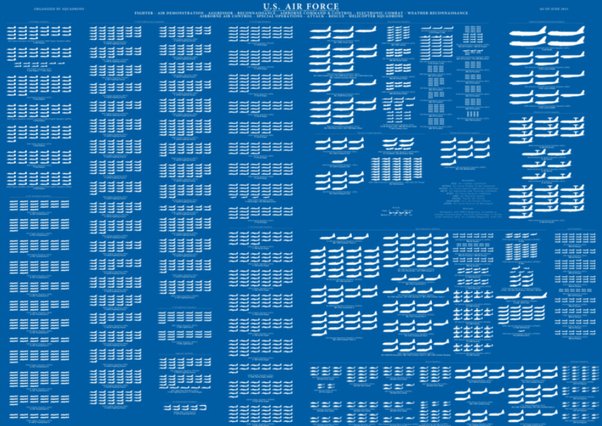
When ordered, the U.S. Air Force assembles a vast aerial armada. It envelops the sky. If required, this package will vaporize everything in its path.
Airmen like to enjoy themselves and have fun. But defending the country is always the highest priority.
My crew served through wars, invasions, special missions, and more deployments than I can remember.
A friend asked if I suffered any post-traumatic stress disorder (PTSD). Not even close. I enjoyed every minute of my Air Force career. My Dad felt the same way.
The military is a brotherhood. It changes you forever.
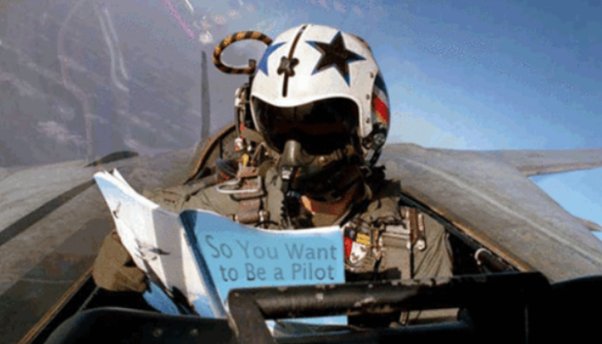 102k views · View Upvoters · View Sharers
102k views · View Upvoters · View Sharers
| The text being discussed is available at
and
| |

